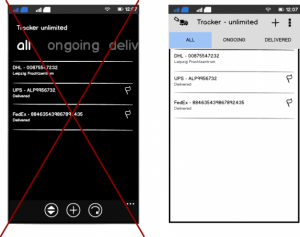Nokia wants apps for its X lineup to have an Android look and feel
 When Nokia officially unveiled its X smartphones it was clear the Finnish company intended its new Android lineup to look similar to Lumia Windows Phones. The internals may be on the low-end side, but the hardware design looks just as premium, undoubtedly aided by the funky colors, and the software... well, the homescreen interface resembles the Windows Phone tiles, which is the dead giveaway as far as this writer can tell.
When Nokia officially unveiled its X smartphones it was clear the Finnish company intended its new Android lineup to look similar to Lumia Windows Phones. The internals may be on the low-end side, but the hardware design looks just as premium, undoubtedly aided by the funky colors, and the software... well, the homescreen interface resembles the Windows Phone tiles, which is the dead giveaway as far as this writer can tell.
Some may rightfully point out that X smartphones are superior to Lumias in one major area -- apps. Courtesy of the mature Android ecosystem, Nokia's droids are compatible with hundreds of thousands of offerings, which is more than Windows Phone can tout. It would make sense for Nokia to encourage developers to make their apps more like those on Windows Phone to warm repeat customers to the idea of upgrading to one of its higher-end smartphones, which run Microsoft's tiled operating system. But, Nokia has other plans.
In the UX checklist section of the Nokia X Design Guidelines, the Finnish company is advising developers to stick to the "Android style", and not confuse users by making their offerings look and feel like they are meant for Windows Phone or other platforms.
Do not mimic different platforms. People are not used to the interaction paradigms of the other platform; for example, they might consider the Windows Phone panoramic view as uneffective since it does not work satisfyingly in landscape orientation.
This sends a mixed message: It is OK for Nokia to mimic Windows Phone's tiles, but it is not OK for developers to mimic Windows Phone's design guidelines in their apps?
The admission that the "panoramic" view in Windows Phone does not work well in landscape mode is not something that one might expect to hear from the company which sold its smartphone division to Microsoft.
Perhaps if Nokia wants to enjoy success with its Android smartphones and entice developers to embrace the Android look and feel it should stop making its handsets and AOSP-based distribution look like Lumias and Windows Phone, respectively. That would not send the wrong message.
But seeing as Nokia is getting rid of its phone-making division by dumping it into Microsoft's yard, the company may be trying to wash its hands of Windows Phone as quickly as possible and open up more to Android. Asking developers to adopt the Android design guidelines is a right first step.
